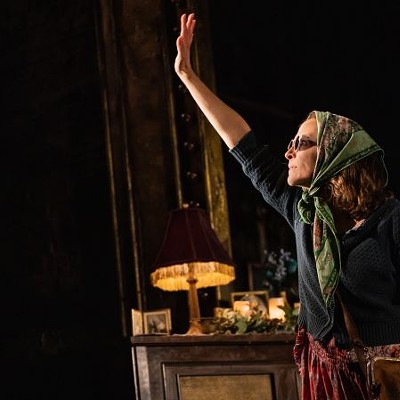A remarkable installation by Japanese artist Yusuke Asai painted entirely with earth found around Houston -- 27 different colors -- is now on view at Rice Gallery. The mural dominates the exhibition room, rising from floor to ceiling, sweeping to three walls and even spilling onto the floor, so huge, so vast as to seem uncontrollable.
Rice University students gathered the colors from 11 different sites, making this the widest spectrum of colors representing a specific place that Asai has ever used. Asai calls dirt a "living medium." He has named the installation "-Yamatane," Japanese for "mountain seed."
While the color tones are primarily brown, by no means does the mural seem monochromatic, as the range of gradations is very diverse. In any case, the immediate strong impression that you're entering a strange and wonderful new world militates against contemplation of colors -- this is their world and it is up to us to be mystified by it.
The installation room is 40 feet deep and 44 feet across with a 15.5-foot-high ceiling, so the sweep and scope of the mural is striking, but perhaps even more striking is the detail of the drawings. Asai has created a phantasmagorical world filled with creatures great and small, a jungle thoroughly populated with denizens, some resembling familiar animals, others alien to the eye.
The work is heavily influenced by Indian folk art, and indeed Asai first won fame when images of his mural in a classroom at the Niranjana Public Welfare School in Bihar, India, spread across the Internet. Using seven different types of soil found in Bihar, Asai had transformed the classroom's bare walls into an imaginative and inspiring place for local children and their families.
With the installation of "Yamatane" at Rice, commissioned by the university, Asai has created a new environment, a habitat that is otherworldly yet inextricably linked to ours. The strange animal figures appear to be friendly, though some are definitely predators. Whether animal, bird or reptile, they almost all seem to be wide-eyed, with a look that may be astonishment. Is it merely a natural alertness in listening for the footstep of a predator, or is it astonishment at the gift of life?
There is considerable wit and humor and a sense of playfulness in the mural, chiefly in the alien figures that rise above the jungle. Some of them seem to be as impressed by the swarming, teeming, varied life below them as we ourselves are.
Asai says, "I do not decide on a story or meaning before I start painting. Imagery of figures and creatures comes to me in the moment. Fox, bird, cat and sunshine -- everything has a role; parts disappear and something is added. The world accepts it and keeps changing. I begin each work thinking of the countless small things that come together to make a larger world."
Asai is self-taught. He says: "I studied ceramics in high school, but when I found it too expensive to go to university, I decided to teach myself. I learned by going to the zoo and to museums, by studying the folk art and tribal art of many cultures and by observing how people create things.
"I accepted the ephemeral nature of dirt as a medium from the moment I started painting with it...When I erase the painting, it is sad, but within the context of the natural world, everything is temporary."
While it is fascinating to be aware that the pigmented materials are from local soil, I wondered how important this is. The mural, after all, could be created using colored chalk or pastels and would look much the same. My feeling is that the use of local dirt is very significant indeed. It makes this on-site installation even more specific and creates a mental connection to the city, a link to native soil.
Asai and two assistants completed the mural in just two weeks, a phenomenally short time for such a massive accomplishment. The fertility of his imagination is evident, as are the originality in his use of materials and his devotion to education -- he continues to assist Indian schools with "Wall Art Festival" projects. In February of this year, Asai traveled to a primary school in the village of Maharashtra belonging to the tribe people of Warli, where, in a classroom, he created "Sprouting Life in the Forest -- Fatherly Tree, Motherly Mountain."
The transient nature of "Yamatane" reminds us of the ephemera of art and even of ourselves. When the installation is over, the earth will be sponged away and the walls restored to their pristine emptiness -- at least until the next exhibit.
"Yamatane" is the first installation of Rice Gallery's yearlong Twentieth Anniversary celebration. Asai's work was commissioned in conjunction with The Menil Collection's exhibition "Experiments with Truth: Gandhi and Images of Nonviolence," on display through February 1, 2015.
The mission statement of Rice Gallery states in part: "Rice Gallery presents temporary, large-scale environments that visitors can enter and explore. Artists typically use inexpensive materials to create stunning works of art."
That last sentence could not express better the success of Asai's "Yamatane."
Yusuke Asai: Yamatane Through November 23 at Rice Gallery, Rice University, 6100 Main, 352 Sewall Hall, 713-348-6069, ricegallery.org.





